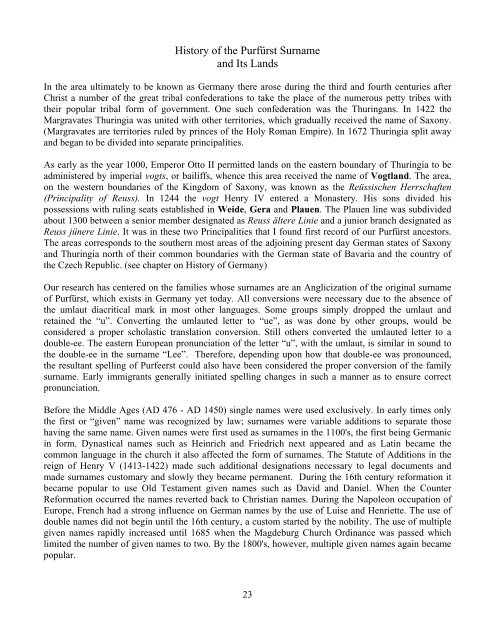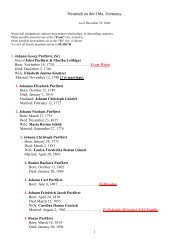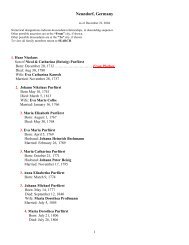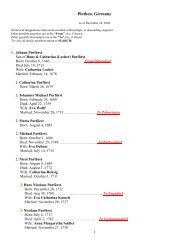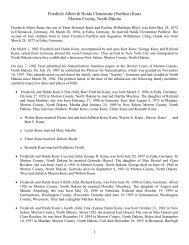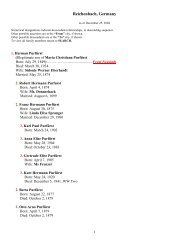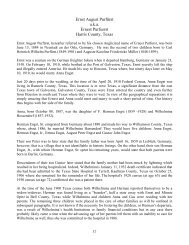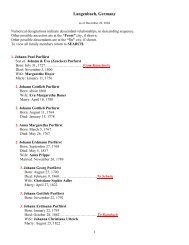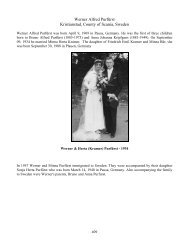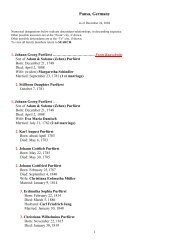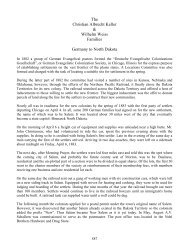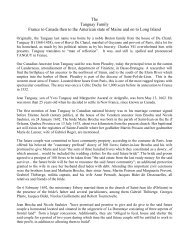3b. German History - Purfürst Surname - Purfeerst
3b. German History - Purfürst Surname - Purfeerst
3b. German History - Purfürst Surname - Purfeerst
You also want an ePaper? Increase the reach of your titles
YUMPU automatically turns print PDFs into web optimized ePapers that Google loves.
<strong>History</strong> of the Purfürst <strong>Surname</strong><br />
and Its Lands<br />
In the area ultimately to be known as <strong>German</strong>y there arose during the third and fourth centuries after<br />
Christ a number of the great tribal confederations to take the place of the numerous petty tribes with<br />
their popular tribal form of government. One such confederation was the Thuringans. In 1422 the<br />
Margravates Thuringia was united with other territories, which gradually received the name of Saxony.<br />
(Margravates are territories ruled by princes of the Holy Roman Empire). In 1672 Thuringia split away<br />
and began to be divided into separate principalities.<br />
As early as the year 1000, Emperor Otto II permitted lands on the eastern boundary of Thuringia to be<br />
administered by imperial vogts, or bailiffs, whence this area received the name of Vogtland. The area,<br />
on the western boundaries of the Kingdom of Saxony, was known as the Reüssischen Herrschaften<br />
(Principality of Reuss). In 1244 the vogt Henry IV entered a Monastery. His sons divided his<br />
possessions with ruling seats established in Weide, Gera and Plauen. The Plauen line was subdivided<br />
about 1300 between a senior member designated as Reuss ältere Linie and a junior branch designated as<br />
Reuss jünere Linie. It was in these two Principalities that I found first record of our Purfürst ancestors.<br />
The areas corresponds to the southern most areas of the adjoining present day <strong>German</strong> states of Saxony<br />
and Thuringia north of their common boundaries with the <strong>German</strong> state of Bavaria and the country of<br />
the Czech Republic. (see chapter on <strong>History</strong> of <strong>German</strong>y)<br />
Our research has centered on the families whose surnames are an Anglicization of the original surname<br />
of Purfürst, which exists in <strong>German</strong>y yet today. All conversions were necessary due to the absence of<br />
the umlaut diacritical mark in most other languages. Some groups simply dropped the umlaut and<br />
retained the “u”. Converting the umlauted letter to “ue”, as was done by other groups, would be<br />
considered a proper scholastic translation conversion. Still others converted the umlauted letter to a<br />
double-ee. The eastern European pronunciation of the letter “u”, with the umlaut, is similar in sound to<br />
the double-ee in the surname “Lee”. Therefore, depending upon how that double-ee was pronounced,<br />
the resultant spelling of <strong>Purfeerst</strong> could also have been considered the proper conversion of the family<br />
surname. Early immigrants generally initiated spelling changes in such a manner as to ensure correct<br />
pronunciation.<br />
Before the Middle Ages (AD 476 - AD 1450) single names were used exclusively. In early times only<br />
the first or “given” name was recognized by law; surnames were variable additions to separate those<br />
having the same name. Given names were first used as surnames in the 1100's, the first being <strong>German</strong>ic<br />
in form. Dynastical names such as Heinrich and Friedrich next appeared and as Latin became the<br />
common language in the church it also affected the form of surnames. The Statute of Additions in the<br />
reign of Henry V (1413-1422) made such additional designations necessary to legal documents and<br />
made surnames customary and slowly they became permanent. During the 16th century reformation it<br />
became popular to use Old Testament given names such as David and Daniel. When the Counter<br />
Reformation occurred the names reverted back to Christian names. During the Napoleon occupation of<br />
Europe, French had a strong influence on <strong>German</strong> names by the use of Luise and Henriette. The use of<br />
double names did not begin until the 16th century, a custom started by the nobility. The use of multiple<br />
given names rapidly increased until 1685 when the Magdeburg Church Ordinance was passed which<br />
limited the number of given names to two. By the 1800's, however, multiple given names again became<br />
popular.<br />
23
At baptism, if two given names were given to the child, the first given name was a spiritual name,<br />
originally developed from Roman Catholic tradition and continued by the Protestants in their naming<br />
customs. The second given name was the secular or call name by which the person was known both<br />
within the family and to the rest of the world. The spiritual name, usually to honor a favorite saint or<br />
person (ruler, land owner, etc) was usually repeatedly given to all of the children of that family of the<br />
same sex. You will see this custom practiced in the early Purfürst families. But after baptism they<br />
would not be known by that first given name but would be known by what we would think of as their<br />
middle name. Equally as important is the fact the name always had a spiritual spelling as well. Thus, for<br />
example, the proper baptismal name for John would have been Johann. A combination of these customs<br />
obviously made research efforts interesting when we American descendants only knew our early<br />
ancestors by their non-spiritualized middle names while all early records of the individual reflected<br />
something entirely different.<br />
The term “Senior” or “Junior” following a name did not necessarily imply a father and son relationship<br />
as it does now. It could have been a uncle and nephew who had the same name and lived close to each<br />
other. It could have been two unrelated individuals with the same name who lived near each other. To<br />
help friends and business associates keep track of who-was-who in their discussions they added “Sr.”<br />
and “Jr.” which simply meant older and younger, respectively. In this family bibliography I have added<br />
such terms to family members when I felt it would help clarify generation relationships.<br />
It was common practice to have strict naming patterns. For example, the first son would be named after<br />
the father's father; the second son named after the mother's father; the third son named after the father;<br />
the fourth son named after the husband's father's father, etc. This custom occasionally provided clues in<br />
determining the possible names of earlier generations. In the 1880's 30-40 percent of children died<br />
before the age of 10. If a child died in infancy the name was often reused. A child's name was also<br />
reused when a spouse died and the surviving spouse remarried and had more children with the next<br />
spouse. This results in two adult children with the same name; an occurrence found in our Purfürst<br />
family tree.<br />
The pronunciation in Saxony differs in relation to other <strong>German</strong> areas. Most significant is that there is<br />
no difference between b and p, between g and k, and between d and t. In fact p, k and t seem to be<br />
completely ignored. The Saxons say that B is a “soft” B and that P is a “hard” B. During my research it<br />
was noted that, at various times, the spelling of the Purfurst name began with a “B”. The name was<br />
frequently spelled with a “B” in old <strong>German</strong> gothic lineage publications.<br />
The Purfürst name is a “High <strong>German</strong>” variation of the original name Burgfürst. The term “High<br />
<strong>German</strong>” applies to dialects spoken in areas of <strong>German</strong>y south of an imaginary geographic line<br />
extending from the French border near Strasburg through the cities of Stuttgart and Nürnburg to the<br />
<strong>German</strong> city of Hof on the Czechoslovakian border. Names changed when a person moved from one of<br />
these regions to another. The surname Burgfürst is known to have existed as early as the year 1321 and<br />
translates to “The First Man on The Castle”, usually a Knight serving a king or duke. For a commoner it<br />
could simply mean a man who lived at the top (the “First”) of the hill. (see chapter on <strong>German</strong>y<br />
Nobility)<br />
The Catholic Church prevailed in the <strong>German</strong> Empire for over 500 years prior to the Protestant<br />
Reformation. During this time many important records began to be kept by church officials concerning<br />
land, tax, court and civil affairs. Secular officials owned many of the churches and many of the<br />
documents and functions later became the basis for public record keeping. The reformation provided<br />
24
much of the impetus for the widespread recording of parish registers in <strong>German</strong>y. The early Protestant<br />
records date from 1523 and most early Catholic records from 1563. The Thirty Years War (1618-1648)<br />
caused extensive damage to records in many areas thus many church records commence from a date<br />
after the war. It was during the maintenance of the parish records associated with the Baptism process<br />
that the educated priests began to cause the continued use of family names with a common spelling.<br />
Bohemia is a historical region in central Europe, occupying the western and middle thirds of the current<br />
Czech Republic. It was an independent kingdom until centralization reforms in 1743, when it became a<br />
part of the Austrian part of Habsburg empire, and <strong>German</strong> became the only official language. A<br />
national Czech movement against (mainly <strong>German</strong>) foreign immigrants was promoted by the religious<br />
movement of Hussites under the leadership of Jan Hus, a precursor of Martin Luther, who was<br />
eventually burned at the stake. When the crusade against heresy was declared by the Pope, it created a<br />
period of turmoil in Bohemia called the Hussite Wars. Bohemia was granted freedom of religion in 1436<br />
by so-called Basel Compactates (Peace and Freedom between Catholics and Utraquists (today:<br />
Bohemian Church)) but this lasted for only a short time, as in 1462, Pope Pius II declared Basel<br />
Compactates invalid. In 1609, Bohemian king Rudolph II, who was titularly a Catholic, was coerced by<br />
Bohemian nobility to publish Maiestas Rudolphina, which confirmed the older Confessio Bohemica of<br />
1575. It can be said that there was relative freedom of religion in Bohemia between 1436 and 1620 and<br />
in this Bohemia was one of the most liberal countries of the Christian world. In 1555 the Conference in<br />
Augsburg granted to the estates of the Empire the right to decide what religion they wish to have (quius<br />
regio, euis religio-he who rules, his religion) and individual people were granted the right to immigrate<br />
if they preferred Protestant. The Protestant nobility were largely expelled after the Battle of White<br />
Mountain in 1620. The ruling classes had largely been <strong>German</strong>-speaking since the late Middle Ages.<br />
After World War I, Bohemia became the cornerstone of the newly-formed country of Czechoslovakia<br />
which became a rich and liberal democratic republic.<br />
The Purfürst family member for whom I found earliest record was born in 1565. This record was located<br />
but 10 Km north of the Bohemia portion of the aforementioned Uberdeutsch "High <strong>German</strong>" area. All<br />
early records of the Purfürst family indicates they were of the Protestant faith thus I think that the<br />
Purfürst surname had is origin in Bohemia and the earliest <strong>German</strong> resident identified may have came<br />
north out of Uberdeutsch Catholic Bohemia area after the Protestant Reformation. It is my supposition<br />
that the earliest ancestor took advantage of that emigration freedom and moved north across the border<br />
into southern Thuringia. Thus my future research may ultimately lead me south to Bohemia (The Czech<br />
Republic). Of course it wasn't until the 1600's when priests caused the continued use of family names<br />
(surnames) with common spelling. Examination of records that predate that period, which reflect only<br />
first names, obviously complicates development of family structures and the conclusion of ancestral<br />
relationships.<br />
Throughout the history of the <strong>German</strong> Empire, wars, epidemics, plagues and pestilence swept through<br />
the land, greatly diminishing the population and causing tremendous material destruction and a dramatic<br />
increase in poverty. The chaos resulting from these disasters allowed for the displacement of many<br />
valuable parish registers and the potential for the undocumented death of family members.<br />
There was not a church in every town and the towns that had a church did not necessarily maintain their<br />
own registers. The residents of each town were assigned to a particular Protestant or Catholic Church in<br />
the area. Depending upon the size of the population a number churches were then assigned to a Parish.<br />
The events of baptism, marriage or burial would have been recorded in the town where that parish office<br />
was located. Thus I have family members indicating they resided in a certain city only to find out that<br />
25
the church in that city does not have records. That policy required me to go in search of the parish office<br />
that did.<br />
26


